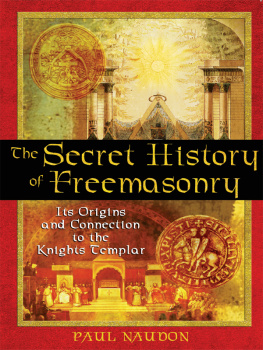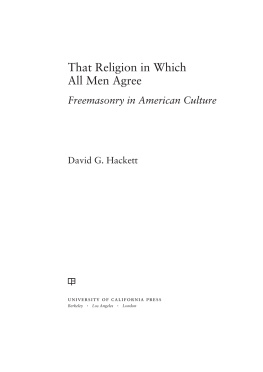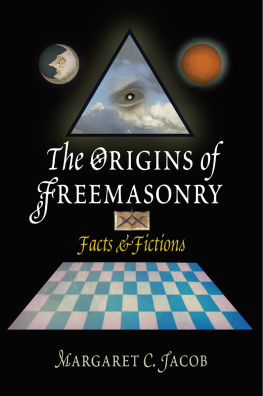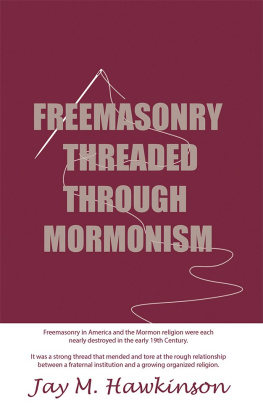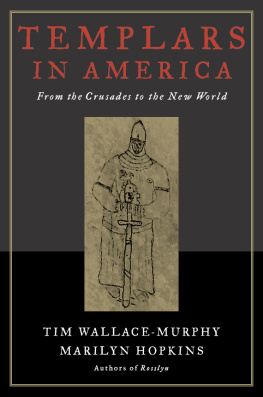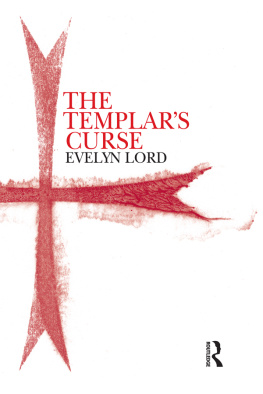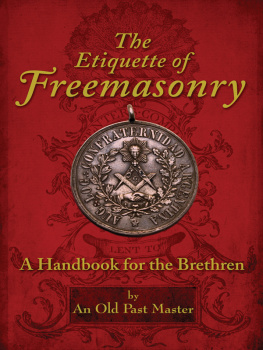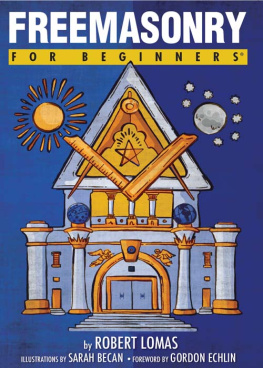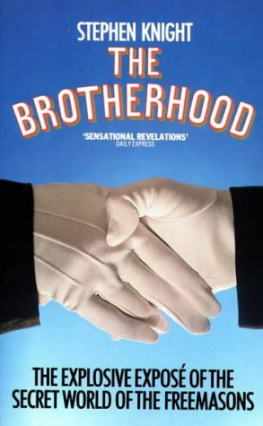The Secret History of Freemasonry
Its Origins and Connection
to the Knights Templar
PAUL NAUDON
Translated by Jon Graham

Inner Traditions
Rochester, Vermont
Contents




Preface
I state with all modesty, and without presuming to underestimate the value of preceding works on the subject, that to date there has been no truly scientific history of the origins of Freemasonry and that such a study is totally justified.
A number of valuable works on the history of Freemasonry have in fact been published since the appearance of the grand lodges at the beginning of the seventeenth century. Indeed, they have flourished in such number since the end of the Second World War that we can now hail the birth of a new discipline, which we might call masonology.
Nevertheless, operative freemasonry, which preceded this modern Freemasonrythe orderfor how can anyone claim to discuss this subject without touching upon this question?have largely contributed insights only to the various fragmentary aspects their individual studies may have addressed. Far too often these studies have consisted of only an isolated, contemporary, and literal reading of documents with which most students of this subject are already familiar. Symbolism, which is the capital rule of Freemasonry, has often been either systematically overlooked or cursorily addressed on the broader historical plane. Some scholars have even believed Freemasonrys symbolism and history to be two separate domains, while others, conversely, have confused symbolism and history, boiling down both to a single reduction and seeking to deduce the meaning of one from the other. The veil formed by these symbolswords, figures, and signshas concealed the structures and realities from them.
We must hasten to pay a well-deserved homage to this research, however, specifically to the remarkable works published since 1886 by the London Study Lodge Quatuor Coronati no. 2076, which has brought to light a significant number of old, specifically British documents. Myriad brilliant authors have applied themselves to the presentation and analysis of these texts, including R. F. Gould, D. Knoop, G.P. Jones, D. Hamer, Lionel Vibert, F. L. Pick, G. N. Knight. Harry Carr, and John Hamil. Their works are quite valuable for their probity, the precision of their notes, and their observations relevant to the factual study of the beginnings of Freemasonry in Great Britain.
This intellectual harvest has encouraged me to intensify the search for a way to better situate the masonic institution and its origins in their general historical and structural context, especially given that the facts related to the institution are inseparable from the social context, mindsets, and motivations surrounding it. Further, while modern Freemasonry has grown directly from an exclusively British framework, its origins and development extend far beyond Great Britain and that nations history in both time and space, a fact that deserves some exploration.
My investigations on this subject have been quite extensive. I have made a point of attending to findings made in earlier works, incorporating those opinions whose premises were supported with proof. Research based on historical sources in all their complexity has been my chief concern. Quite often this research has led me to subject areas that might seem quite foreign to the topic at hand, such as archaeology, ethnography, sociology, law, and political economics. History, however, is traced not only through documents, but also through reconstructing the institutions, mores, and lifestyles in the past. The historical method is, by necessity, multidisciplinary in its theories and hypotheses. Nothing can be examined in complete isolation, in abstracto. Life is unity within diversity. I have consistently sought to gather what was scattered in order to reconstruct a living past and, consequently, one that is as close as possible to reality and truth.
Setting off on my journey objectively and without any preconceived notions, I have had to surrender to the evidence showing that certain opinions expressed in what are accepted as fundamental works on Freemasonry are actually lacking any basis of support.
Conversely, the same rectitude of thought and judgment led me to the opposite conclusion: that certain legends whose credibility had been greatly shaken among positivist minds were, in truth, based on sound arguments. This is especially the case for the Templar origins of Freemasonry. It should be clearly stated, though, that this does not mean I believe modern speculative Freemasonry is a direct survival of this vanished Order.
For their ceaseless understanding, kindness, and strong encouragement, I thank all those in the wide variety of fields I have explored in the undertaking of this book. I give my acknowledgment and thanks to all those who gave me their assistance or showed interest in the work I was doing. Certainly I am aware of the gaps that remain in this product. My ambition is to inspire further study in this fascinating subject that remains in large part unexplored.

Introduction
Behold the days come, oracle of the Eternal... I will set my law within them and write it on their hearts... Behold the days come that city shall be built.
JEREMIAH 31:3338
T o find the origins of Freemasonry, it is important first to isolate its original characteristics, which can be found in the institutions from which it appears to have emerged:
1. It was a professional buildersor, more precisely, constructionorganization; the long-ago vocation of mason does not correspond directly to the modern specialization, but included an extensive knowledge of architecture. The organization was represented hierarchically.
2. The organization extended beyond a strictly professional framework. Its members considered themselves brothers and provided mutual assistance.
3. The association, in both its operations and assistance, followed traditional rites. Members were accepted into it through an initiation and the brothers were united by sacred practices that were illustrative of an asceticism, an indispensable condition for the realization of the work.
4. The association accepted members who were not practitioners of the trade.
5. The association displayed and highlighted its character of universalism.
This study of Freemasonry looks at both its specific history and the influences and events that have left their imprint over time on its formation and evolution. As such, it includes an examination of various spheressocial, juridical, religious, and philosophicalthat have conditioned these events.
From a chronological perspective, the most certain sources of Freemasonry have emerged as the following:
1. The Roman collegia, the remnants of which remained in the West following invasions and survived in the East as institutions discovered by the Crusaders at the end of the eleventh century.
2. The ecclesiastical associations of builders formed by the bishops of the early Middle Ages, especially the Benedictines, the Cistercians, and the Templars.
3. Trade-based freemasonry, which was born under the aegis of these associations and followed the form of lay brotherhoods or guilds.
Next page
